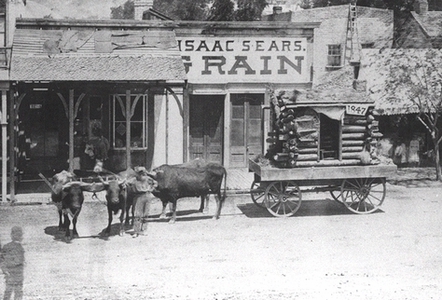PIONEER DAY

Ox-drawn float, Pioneer Day, 1880
The first company of Mormon pioneers, led by Brigham Young, officially entered the Valley of the Great Salt Lake on 24 July 1847. For Latter-day Saints, this event has come to signal the founding of a new homeland for the purpose of establishing their earthly Zion.
Mormon pioneers first commemorated this new beginning in 1849. The celebration took place near the spot that Young had recently designated as the site of a future temple, the holiest place in Mormondom. The observance consisted of a procession which led Brigham Young from his home to a bowery on Temple Square to which members of the nearly twenty local LDS congregations had marched earlier that morning behind their respective bishops. Under the bowery, Young presided over a devotional full of both religious reverence and zeal. The celebration ended with a thanksgiving feast for a bountiful harvest and the blessings of a merciful God.
From these obscure but auspicious beginnings, Pioneer Day (also called Covered Wagon Days, Days of `47, or simply July 24th) has grown into one of the largest regional celebrations in the United States. Salt Lake City remains the center of this observance, but the founding of a Mormon homeland is annually commemorated throughout the Mormon Culture Region and elsewhere among LDS congregations. In the words of sociologist Thomas O'Dea, Pioneer Day has become "the greatest Mormon holiday."
As is became established as a major Mormon tradition, Pioneer Day was celebrated as a birthday, an independence day, and a thanksgiving day for Mormons, as well as a foretaste of the celebration of the Saints that would usher in the millennium at the end of time. During the celebrations, major social groups (based on age, gender, marital status, occupation, residence, and ecclesiastical or civic position) interacted in ways to ritually review the society's vitality and solidarity. Customary activities--including parades, devotionals, sporting events, feasts, dances, excursions, and reunions--also often served to remind the Saints of the religious foundations of their group identity. The specific meanings of Pioneer Day for Mormonism can be best seen through a series of historical vignettes.
In 1857 several thousand Mormons gathered in the mountains east of Salt Lake City for the tenth anniversary of the founding of their western Zion. In the context of one of the largest and most exuberant public displays of Mormonism to date, the celebrants became aware of the approach of Johnston's Army, which initiated the tense but essentially non-violent Utah War.
During the subsequent "federal occupation" of Utah, Pioneer Day was celebrated little, if at all. Once the tension had subsided, however, the Mormons renewed celebrating their heritage. The observance of Pioneer Day expanded as the Mormon Culture Region filled the Intermountain West. In the 1860s and 1870s this celebration reflected the self-proclaimed identity of the Latter-day Saints as "modern Israel," chosen and lead by God to prepare the earth for the millennial reign of Christ.
In 1880 the Mormons commemorated the fiftieth anniversary of the church's formal organization. Although this event was remembered at the church's semiannual general conference in April, its principal observance was on 24 July. Tens of thousands of Latter-day Saints in hundreds of communities participated in this jubilee, which was as enthusiastic a celebration as the Mormons had ever created.
The following years saw Mormonism face the anti-polygamy persecutions that nearly produced its demise. Pioneer Day celebrations were subdued or informal and reflected the ambivalence of this period. The 1886 celebration was particularly poignant. The tabernacle on Temple Square was draped, not as usual in colorful bunting, but in black, as for a funeral, and pioneers and church leaders who were in hiding or prison for "unlawful cohabitation" were eulogized for their devotion to the cause of Mormonism.
In contrast, for the 1897 jubilee the Mormons pulled out all the stops. They were celebrating not only the fiftieth anniversary of the arrival of the pioneers, but also the completion of the Salt Lake Temple, Utah statehood, and the virtual end of anti-polygamy persecutions. The spiritual and historical legacy was amply displayed and celebrated, as were the agricultural and industrial products of their efforts in their land of promise. The details and activities of the celebration reinforced Mormonism's security about its past and confidence about its future.
In the twentieth century, Pioneer Day has increasingly reflected the cultural and religious heterogeneity of the Mormon Culture Region and of the LDS Church in general. To be sure, pioneering ideals have remained dominant in the celebrations, but the usual themes of "frontier," "homeland," "Zion in the tops of the mountains," and so on have been increasingly applied metaphorically to concerns and ambitions, not exclusively of the Mormons, but of the wider societies in which Latter-day Saints live. In larger cities, especially, the celebration has become more secular, and is seen as a means of coming together and celebrating the society that has been built by Mormons and non-Mormons alike. Though to Mormons the celebration may always bring to mind the pioneers of 1847, to the society as a whole the day is one to celebrate the building of the society by "pioneers" of many eras and backgrounds.
Disclaimer: Information on this site was converted from a hard cover book published by University of Utah Press in 1994. Any errors should be directed towards the University of Utah Press.